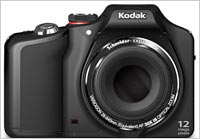 When it comes down to it, Kodak may become a case study of what happens when a company continues to innovate, but fails to recognize how those very
innovations will change the industry.
When it comes down to it, Kodak may become a case study of what happens when a company continues to innovate, but fails to recognize how those very
innovations will change the industry.
Less than a month after filing for bankruptcy protection, the venerable brand announced Thursday it was effectively getting out of the camera business,
phasing out its digital camera, pocket video and digital picture frame lines by the middle of this year. While the company will continue its consumer-facing online and retail-based photo printing, as
well as production of desktop inkjets, ir is clearly a casualty of the ways in which consumer photography has fundamentally changed in a relatively recent time frame.
“Eastman Kodak
didn't start as a technology company, creating groundbreaking cameras, they started as a chemical company making cheap, affordable cameras and making the bulk of their money off consumables like film
and paper,” writes Jennifer Jacobson, a representative for consumer electronics Web site Retrevo.com in an e-mail to Marketing Daily. “We live in an instant gratification society
when it comes to pictures. People want to share their pictures with friends and family. the day, even the moment, those pictures are taken. ‘Prints’ are no longer something people want on
a regular basis.”
advertisement
advertisement
When Kodak filed for bankruptcy protection in late January, many observers and commentators were quick to point out the company’s missteps, in particular the
company’s invention of the first digital camera in 1975. But because the company was so steeped in the film and developing market, the technology was put on the back burner for fear of its
cannibalizing the main revenue source.
“If you want to point back to the most pivotal moment that caused this, it was back in 1975 when they discovered the digital camera and put it back
into a closet,” former Kodak CMO Jeffrey Hayzlett told Mashable shortly after the company filed for bankruptcy.
The
company also failed to acknowledge the different ways in which people were sharing their photographs with others. Although Kodak introduced the EasyShare camera (which allowed people to email photos
directly from their cameras via WiFi networks), the rise of social media and camera phones fundamentally changed the way consumers interacted with photographs.
“Kodak is a classic case
of [a company] not understanding what business they were in,” says advertising agency search consultant (and former agency executive) Avi Dan. The lesson, Dan says, is “if you don’t
cannibalize yourself with the latest technology, someone else will.”
Still, the company professed the move was the best way to keep moving forward. In its announcement, Kodak said moving
out of the consumer products area would save the company $100 million a year (despite taking a $30 million charge to get out of the business). The company also holds thousands of patents, which would
likely be attractive to many businesses that will be producing digital cameras in the company’s wake.
“It seems to me the strategy the current CEO is taking is interesting,”
Dan tells Marketing Daily. “It has a fairly reasonable chance of success. It’s not going to be easy, of course, because there are formidable competitors.”